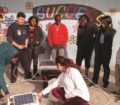 BENJAMIN SIEGEL
BENJAMIN SIEGEL
Truckee Meadows Community College
Mentors: Hans Moosmuller, Desert Research Institute
Jim Cotter, Truckee Meadows Community College
The Effects of Dust Deposition on Solar Panels
This experiment’s objective is to analyze the effects of mineral dust deposited on solar cells on the amount and spectrum of light available to these cells. Using the DRI dust entrainment facility, dust will be suspended into a controlled volume, where some of it will settle on ultrathin glass slides. The mass of dust deposited on a slide will be determined by weighing the slide before and after deposition, yielding the deposited dust mass as difference. Similarly, shortwave solar radiation will be passed through the slides before and after dust deposition and the spectral transmission will be quantified with an optical spectrometer, yielding the spectral dust extinction from the difference of optical transmission. The mass extinction efficiency can subsequently be calculated as the extinction per deposited mass. Effects of several different dust samples will be characterized, including dust that is purely scattering and dust that has strong absorption at some wavelengths. Results of this study will help in better understanding deterioration of solar call performance due to dust deposition and in optimizing cleaning procedures and schedules.




